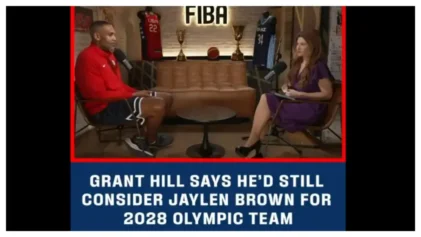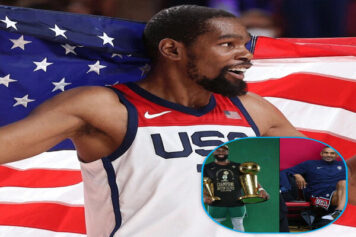In what should be the marquee game of this year’s Sweet 16, Kentucky and Louisville will tip off tonight with the collective eyes of the basketball world focused in on the action taking place at Lucas Oil Stadium in Indianapolis. It’s a basketball rivalry forged in Bluegrass heaven.
The last time they met on a stage this big, Anthony Davis and Kentucky defeated the Cardinals in the 2012 Final Four en route to Coach John Calipari’s first National Championship, and Kentucky’s first since the team was coached by Tubby Smith in 1998.
Most people who follow college hoops today take the continued excellence of the Kentucky Wildcats for granted. But it wasn’t very long ago that the storied program was nearly given the death penalty by the NCAA after numerous infractions by former coach Eddie Sutton in the late 1980’s.
When the severe sanctions were handed down, crippling the program, the school turned to a native New Yorker, the coach of the New York Knicks at the time, to re-build the empire. That man was Rick Pitino, who'll stand on Louisville’s sideline tonight as the Cardinals head coach.
So how did Pitino resurrect the program and return the Wildcats to the penthouse of college hoops? He brought some Lexington Avenue flavor to Lexington, Kentucky.
Pitino went back to his hometown and found that one transcendent player who could not only put a team, but a program, a university and an entire state, on his broad shoulders and lead the Wildcats back to national prominence. He went back to New York City and returned with a monster.
Monster Mash, to be more exact.
Standing 6-foot-8 and carrying a chiseled 240 pounds on his muscular frame, Jamal Mashburn was the textbook example of versatility. Whether pulling up from 23 feet to bang a three, dominating in the post, snatching rebounds or running the show in the open court, the man could do it all. And then some.
"His hands are awesome, and his lower body's so strong," Pitino told Sports Illustrated in November of 1992. "From coaching Charles Oakley and Bernard King and watching Karl Malone and Kevin McHale, I know about NBA moves, and Jamal has all of theirs. He has a ball-fake-and-go-by-you. A baseline turnaround. And a great up-and-under."
Jamal Mashburn was born in New York City in 1972. His home court was the hallowed Holcombe Rucker Memorial Playground in Harlem, which was a mere stone’s throw away from his apartment in the Rangel Homes on 155th Street in upper Manhattan.
Some of the ingredients that blossomed into his game were earned the old fashioned way, by simple inheritance. The dazzling footwork and competitive spirit was handed down by both parents.
His mother, Helen, was an accomplished high school sprinter. His father, Bobby, was a former pro boxer with a mean left hook that earned its own nickname, “The Mash Smash.” Bobby, a New York City police officer, fought Larry Holmes and Ken Norton during his career, in addition to serving as Muhammad Ali’s sparring partner for a stretch.
But the beginning of Jamal’s journey was rather inauspicious.
“When he was younger, Jamal had a hard time even getting chosen for a team when they played in back of the building,” his cousin Russell Glover once told Bill Rhoden of the New York Times. “They called him a big baby, said he would never make it.”
But the hours invested on the asphalt – playing with and against skilled, bigger and older players, in an environment where hoops is as essential as oxygen – yielded a monster in the making. In high school at Cardinal Hayes, however, Jamal had a reputation for being a talented but lazy player.
But by his senior year in 1990, that label quickly evaporated. There were many high-level college prospects that season in the CHSAA, New York’s Catholic league, including Christ the King’s Khalid Reeves, Jamal Faulkner and Derrick Phelps, along with Tolentine’s Adrian “Red” Autry and Brian Reese.
Mash was much less celebrated, in part because his high school coach Tom Murray had restricted him to playing solely around the basket. But during his senior year, Murray utilized him all over the floor, realizing that he was the best ball-handler and shooter on the squad.
Mash played every position on the floor. He was a deft as any guard playing out on the perimeter and as rugged and effective as any big man in the post. Cardinal Hayes went on to win the city championship, beating All Hallows 52-46.
Mashburn collected 18 points and seven rebounds in that championship game, but it was his defense that really stood out as he guarded and held future St. John’s University player Shawnelle Scott to only two points. It was Cardinal Hayes’ first city title since 1944.
Tom Konchalski, the legendary high school scout, said that Mashburn had “…the body of a blacksmith and the touch of a surgeon. He just didn't have the disposition to dominate. But at the end of the season Tom Murray stopped lighting him. He realized Jamal was the best ball handler on the team and let him go out on the floor. Cardinal Hayes won the city championship, and Jamal invented a new position. You might call it 'point center.'”
Mash hadn’t been named a prestigious McDonald’s High School All-American and in coaching circles, the word, as Konchalski wrote, was that he didn’t have the disposition to dominate on the next level.
But Rick Pitino saw the diamond in the rough. When Mash announced that he was heading to Kentucky to play for the demanding coach, the doubters opined that he’d never fit into a system of pressing and running.
But the coach at Christ the King High School in New York, Bob Oliva, saw things differently.
“I said at the time that it [Mashburn playing for Pitino] was like giving an atomic bomb to a terrorist,” Oliva told Sports Illustrated.
During his freshman season in Lexington, Mashburn deferred to his teammates while averaging 13 points per game. As a sophomore, he ripped the nets for 21 points per game.
Most people only remember Christian Laettner’s game-winning shot at the buzzer on this exact day, March 28th, 1992, in the East Regional Final that many call the greatest college basketball game ever played.
Duke won that classic against Kentucky during Mashburn’s sophomore year, 103-102, in overtime. They’ll never forget Grant Hill’s pass to Laettner and the incredible shot that won the game. I know I never will. I’ll also never forget how Bobby Hurley played the point that day while scoring 22 points and dishing out 10 assists.
But despite all of that, my most fervent memory is of Jamal Mashburn putting in more work than Samuel L. Jackson with his 28 points, 10 rebounds and three assists before fouling out and having to watch the game’s final moments from the sideline.
During his junior year, and last in college, he averaged 21 points, eight rebounds, four assists and two steals per game en route to being named a First Team All-American.
Mash led Kentucky to the Final Four in 1993, where they lost to Michigan’s Fab Five in overtime, 81-78. He had 26 points and six rebounds in that semifinal contest. Had he not fouled out with 3:23 left in the game, the mystique of the Fab Five might be slightly diminished because it is very much within the realm of possibility that Kentucky, and not Michigan, would have advanced to play for the national championship.
He was the cornerstone and foundation of the rebuilding project that would ultimately bring Pitino and Kentucky a National Championship in 1996. Even though he was in the NBA by that time, the title does not land in Lexington without the domino effect created by his three- year run from 1991-1993.
Without Mash, Kentucky doesn’t come back from the ashes of scandal and probation to regain its elite status on the college hoops landscape within such a short period of time.
He was as unselfish a prolific scorer that you’ll ever see, with an understanding and appreciation of the game that was advanced beyond his years. He was the complete package, whose domination and artistry should be cherished by anyone who calls themselves a basketball fan. He was, indeed, The Monster Mash.



